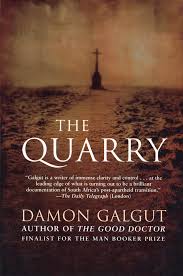 Last week I glutted myself on works by Damon Galgut — an author whose tensile prose compels the reader to struggle with the protagonist on a journey of self-realization. I started with his short stories: An African Sermon (August 2004) begins with a train journey and weaves in a personal confrontation with the Rwandan genocide. (Regarding this topic, works by Jean Hatzfeld and Romeo Dallaire are essential). The Conversation (Oct 2006) tracks Father Angelo through a crisis of faith in the midst of an African conflict: What is faith? What is humanity? What is my role in it? The Lover (Dec 2008) details a loner’s journey through Africa (and on to Europe) while he grapples with social awkwardness and self acceptance, which stymie his love’s desire. Galgut cleverly embodies the protagonist’s fractious nature by fluctuating between the first and third person to mark changes between his “true”-self and his observing-nature.
Last week I glutted myself on works by Damon Galgut — an author whose tensile prose compels the reader to struggle with the protagonist on a journey of self-realization. I started with his short stories: An African Sermon (August 2004) begins with a train journey and weaves in a personal confrontation with the Rwandan genocide. (Regarding this topic, works by Jean Hatzfeld and Romeo Dallaire are essential). The Conversation (Oct 2006) tracks Father Angelo through a crisis of faith in the midst of an African conflict: What is faith? What is humanity? What is my role in it? The Lover (Dec 2008) details a loner’s journey through Africa (and on to Europe) while he grapples with social awkwardness and self acceptance, which stymie his love’s desire. Galgut cleverly embodies the protagonist’s fractious nature by fluctuating between the first and third person to mark changes between his “true”-self and his observing-nature.
The Good Doctor (2003), a Man Booker finalist, explores the tension in characters stationed at a remote (and barely necessary) hospital. Unresolved struggle is a trademark of Galgut’s writing, and he employs Africa’s stark, arid, and abandoned landscapes to explore it. Reading such a work is like being underwater and trying to reach the surface; however, you never do, so that you marvel that you’ve stayed under so long. But in the end you realize you were never swimming in water, but through your own streams of consciousness; thus, desperation, despair, difficulty, and despondency come to define humanity.
The Quarry (1995, 2004), was not published outside of South Africa until the success of The Good Doctor; however, this quirk of fate remains puzzling to me since I found The Quarry to be much more satisfying, and this novel was turned into a film that won Grand Prix of the Americas at the 1998 Montreal Film Festival. Here Galgut meanders his story around an abandoned quarry, which now houses a dead body and illicit drugs; such a feature, however, only helps focus the blight on the human landscape, as a criminal impersonates the minister he just murdered. Galgut first experimented with pronouns here: at the end of the book he uses no proper nouns; instead, the third person refers to a number of characters, each with its own short chapter (only the capitalisation of each pronoun differentiates the characters). This device successfully adds to the novel’s depth and demands a close reading.
In The Impostor (2009), Adam has let his life slide away. Unsure of who he his, he recalls that he once wrote poetry, and sets off to the country to be a poet. In his brother’s cottage the weeds have grown so thick that Adam gets a reprimand from the township. He plans to cut them back, but doesn’t so they become a symbol of his impotence (in writing as well). One day he decides it’s enough and heads to the hardware store for equipment where he meets Canning. Canning’s wife inspires him to write once more, but he soon learns that the lovely spot he spends his weekends at will be destroyed. Once more the protagonist must explore his own depths to come to terms with himself.
Reading Galgut can be like driving down a road on which you have no sense of direction or control, but at the end you’ll have exorcised humanity’s (and your own) woes. His exceptional prose keeps your foot on the accelerator until the end where you gain an un-obstructed view of the entire journey. As a side note Alistair Morgan, another South African author (and Plimpton prize winner), processes similar angst via the landscape. I just applied for FIFA 2010 tickets; hopefully I’ll be able to visit South Africa’s compelling scenery then.



No comments:
Post a Comment